Research Design
A qualitative research.
Data gathered from the company’s official site, press releases, and literature analysis.
Data was used to:
- describe and analyze the current situation;
- determine the company’s crisis strategy.
Our research is qualitative. The information about the core values and strategies of Volkswagen was gained through the analysis of the data from the company’s official site as well as relevant press releases. The data concerning the crisis of Volkswagen was gained through the analysis of press releases. The theoretic information concerning strategic and management that was necessary for the evaluation of the possible strategies was gained through literature analysis.
The gathered data was then analyzed to provide information concerning the company’s environment and strategy.
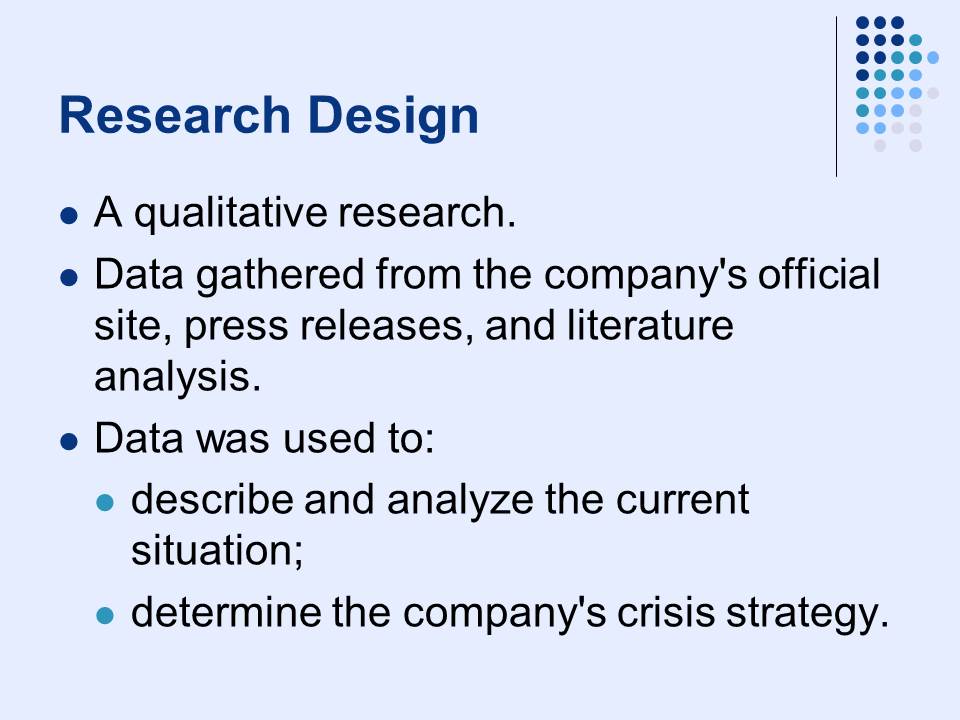
Summary
- The overview of Volkswagen Aktiengesellschaft;
- Current crisis;
- Current strategy;
- Strategic planning options;
- Recommendations;
- Conclusion.
Upon describing all the factors relevant to the choice of a strategic planning option, the evaluation of the possible options was carried out. As a result, we managed to suggest some recommendations concerning the future actions of the company in the field, and a conclusion was made about the possible outcomes of both adopting and ignoring the proposed ideas.
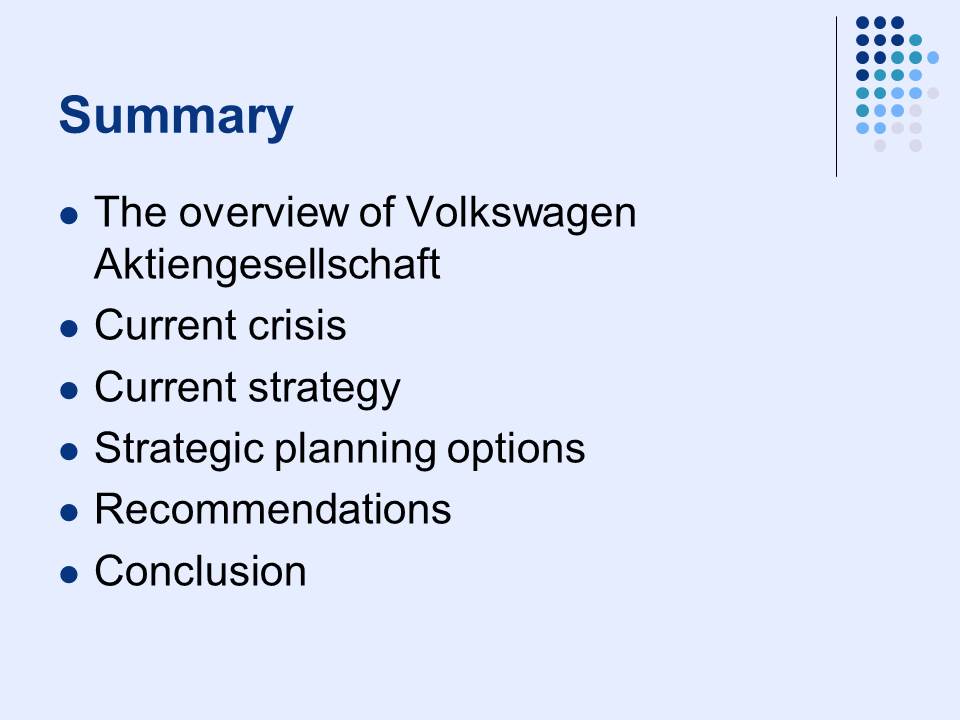
Volkswagen: Overview
According to Hoover’s (2015), Bloomberg Business (2015):
- Almost 80 years of operation.
- 11 brands.
Volkswagen Group or Aktiengesellschaft (VW) is a group of car manufacturers that develops, produces, and sells passenger cars, light commercial vehicles, motorcycles, trucks, and buses as well as their parts; apart from that, the company offers other machinery like “turbo compressors, industrial turbines, and chemical reactor systems” (Bloomberg Business, 2015, par. 1). VW owns luxury and family car brands, including AUDI, Lamborghini, Bentley, Bugatti, Seat, and Skoda; apart from that, the company’s share in Porsche is 49.9% (Hoover’s, 2015, para. 1).

Competition
- #1 in Europe; 10 million cars per year.
According to Hoover’s (2015), VW is the Europe’s #1 carmaker with its annual production amounting to 10 million cars, trucks, and vans. Apart from that, the company operates South and North Americas, and the Asia-Pacific Region. According to Hoover’s (2015) and Morningstar (2015), the list of VW’s competitors includes Toyota Motor Corp and General Motors Company. The company’s board of directors believes that their products are capable of achieving success despite the challenging environment (Volkswagen Aktiengesellschaft [VW AG], 2014).
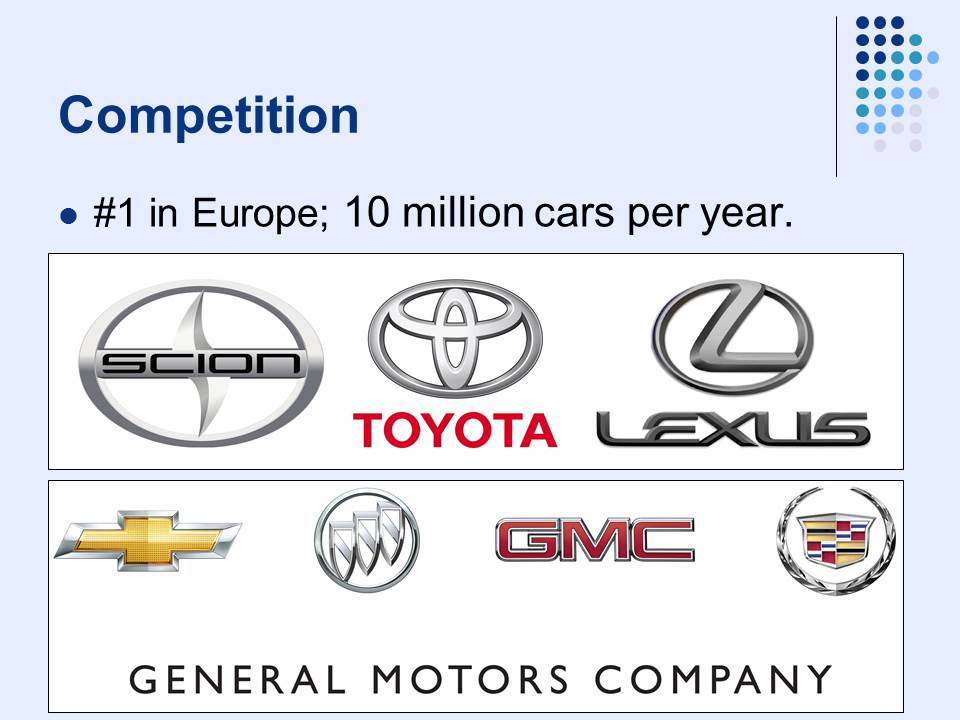
Competitive Advantage (Beene 2015b)
Official website data:
- Environment-friendly cars.
In reality:
- Cheating software.
Being an international car manufacturer giant, VW possesses a number of strengths that include, for example, its size and reputation that is compiled of the fame of the numerous unique brands. Still, the main strength that the company used to pride itself on is the VW environmentally friendly cars like, for example, this supposedly clean-diesel Golf TDI (VW AG, 2014). It is the clean diesel that the company used to regard as its competitive advantage, that is, the feature that “sets the organization apart” (Coulter, 2013, p. 46). However, a major fraud that was uncovered recently shattered this ground that VW used to rely on. The fact that, when on the road, VW cars would emit much more dangerous NOx gasses than was declared or allowed was confirmed two years ago by the International Council on Clean Transportation. This year, the fraud was confirmed first by the US Environment Protection Agency (EPA) and then by VW itself.
As it turned out, VW “used special software to manipulate its emissions controls during U.S. emissions tests, effectively doctoring its emissions results on seven model years’ worth of diesel vehicles going back to 2009, in violation of the Clean Air Act” (Beene, 2015b, para. 2). It should be also pointed out that, according to the company’s senior managers, a withdrawal of crucial documents took place, as a result of which the board of directors was misinformed and allowed this to happen (Reiter & Rauwald, 2015).
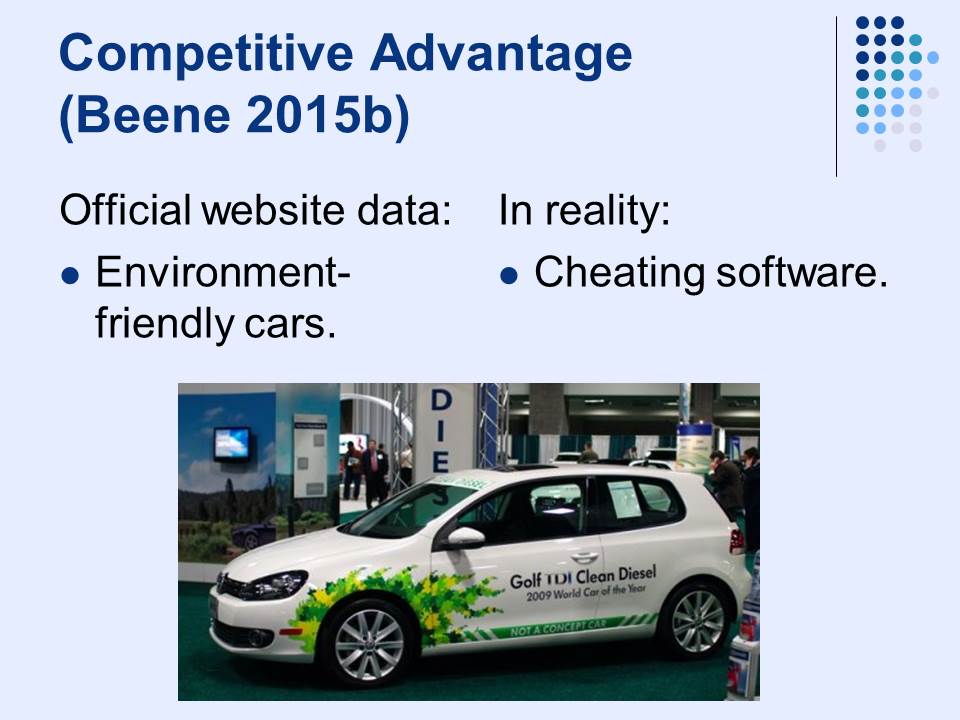
Emission Scandal in Numbers (Kapadia & Downs, 2015)
Let us get the understanding of the key features of this scandal with the help of this Wall Street Journal video.
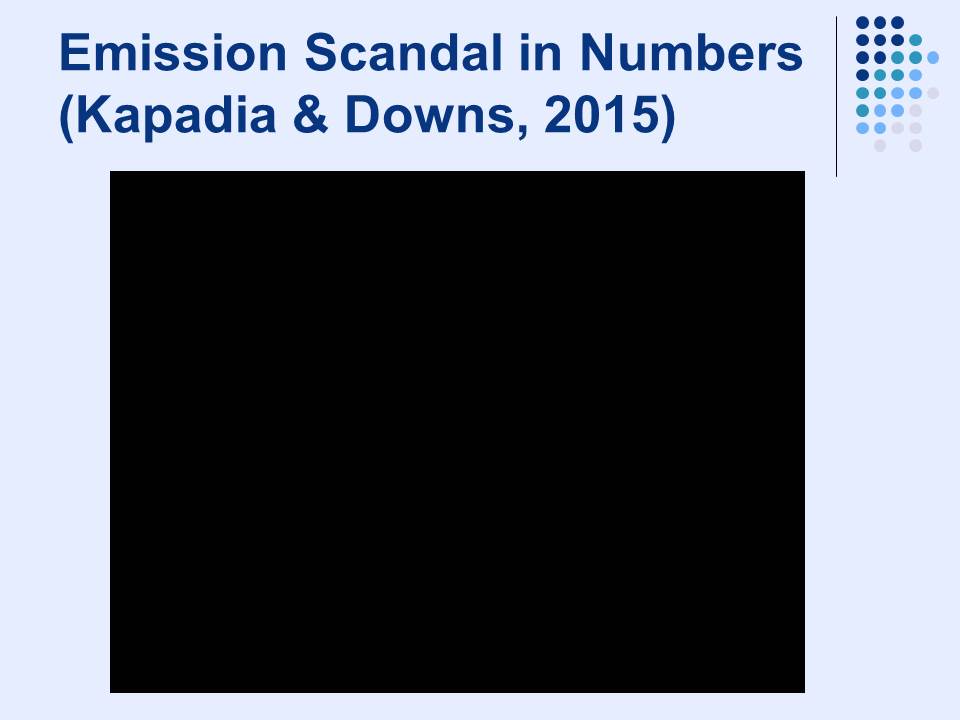
Results: Current Situation Analysis
- Unexpected amounts of NOx emissioned.
- Increased attention to other carmakers (Beene 2015a).
- Danger of layoffs and dismissals.
- Major crisis for VW: share prices drop, fines and withdrawals, damaged reputation.
The actions of VW have a number of consequences. For the environment, this fraud means that the actual emission of the harmful NOx has been much bigger than expected (“The Volkswagen emissions,” 2015). For the industry, this means that the claims of the manufacturers concerning their self-certification tests will be verified more closely (Beene, 2015a). For Germany this means, that a company which employs every seventh worker is in danger of major layoffs (Münchau, 2015). As for VW, the scandal can cost it over 20 billion euros, its shares price has dropped dramatically, and, most importantly, its reputation has been severely damaged (Reiter & Rauwald, 2015). The problem was described by the company as a crisis, which is understandable in the light of the fact that the company is losing its competitive advantage along with the trust of authorities and, most importantly, customers.
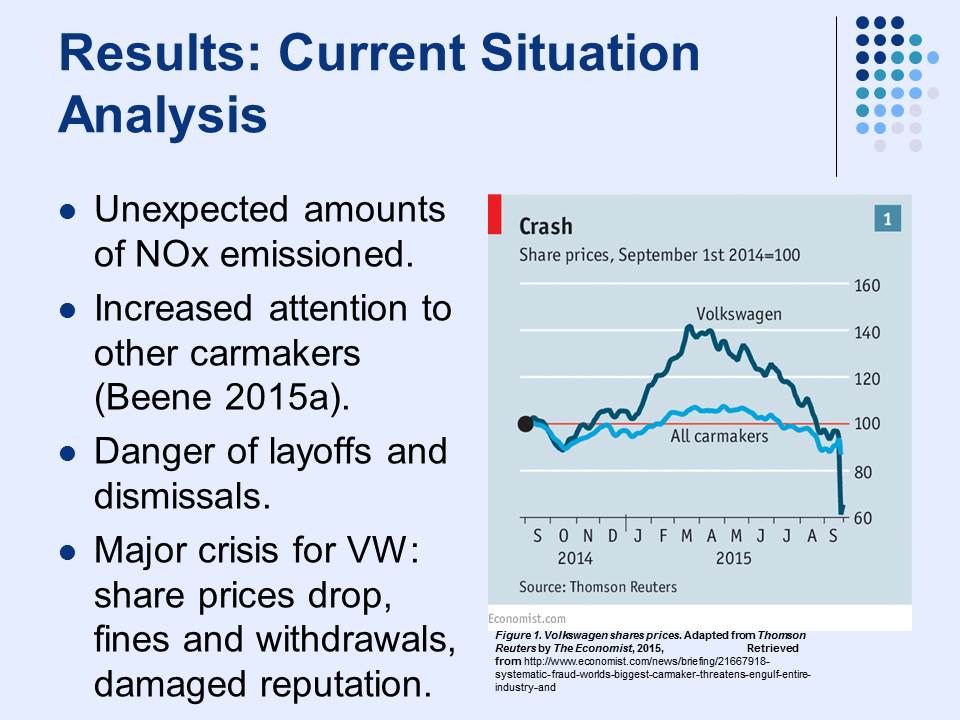
Public Reaction
The reaction of the public was not positive at all. The audacity of the company that had dared to cheat its customers for years has caused a public outcry which is reflected in these pictures. Moreover, the public figures of Germany have expressed their concern about the reputation of the country’s export in Germany since, indeed, VW has become a national brand (“A Mucky Business”, 2015).
VW board of directors labeled the situation as a “political and moral catastrophe” (Reiter & Rauwald, 2015, para. 7). Indeed, the core values that the company had claimed to maintain have been betrayed by VW’s actions, and this is probably one of the main reasons for the damage that was dealt to its reputation. The behavior of VW had been both illegal and unethical, and while the former results in fines and withdrawals and its results can be rectified at the production level, the latter has a more severe impact on the brand’s popularity and is much harder to redeem.
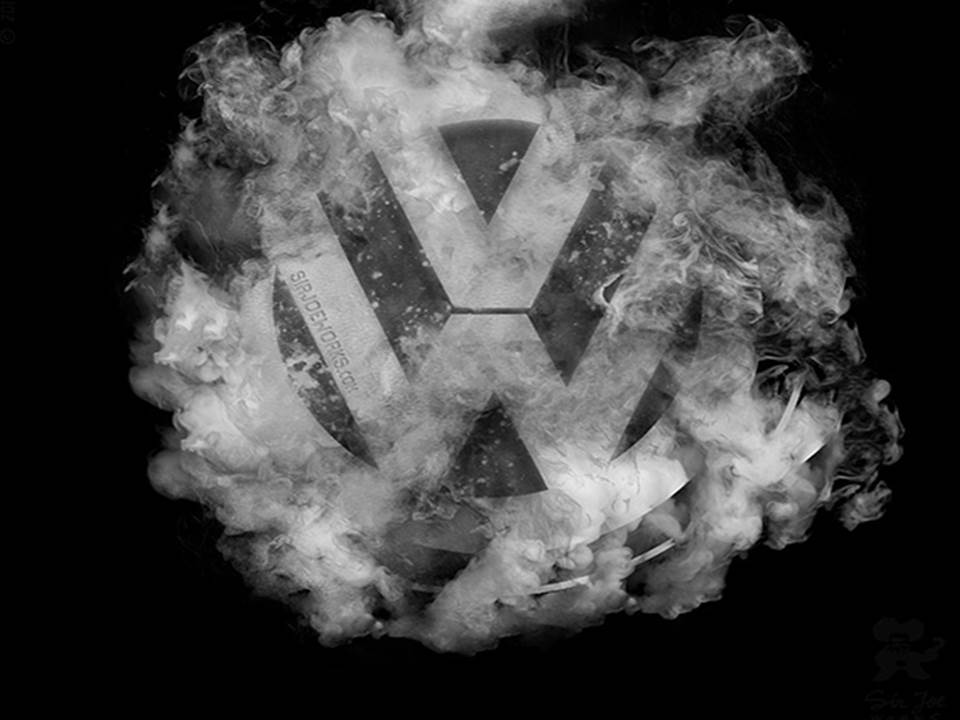
Competitive Disadvantage
- The competitive advantage is lost.
- Potential loss of US market.
One of the most important results of the scandal is that the so-called competitive advantage of VW is no longer an option since it is obvious now that the company has yet to discover its “clean diesel.” Having lost the trust of the customers and authorities, VW has the chance of failing to receive EPA certification for the next year. As you can see from the figure 2, VW is already underrepresented in the US market when compared to its competitors; lack of EPA certification would reduce the company’s share of the market further.
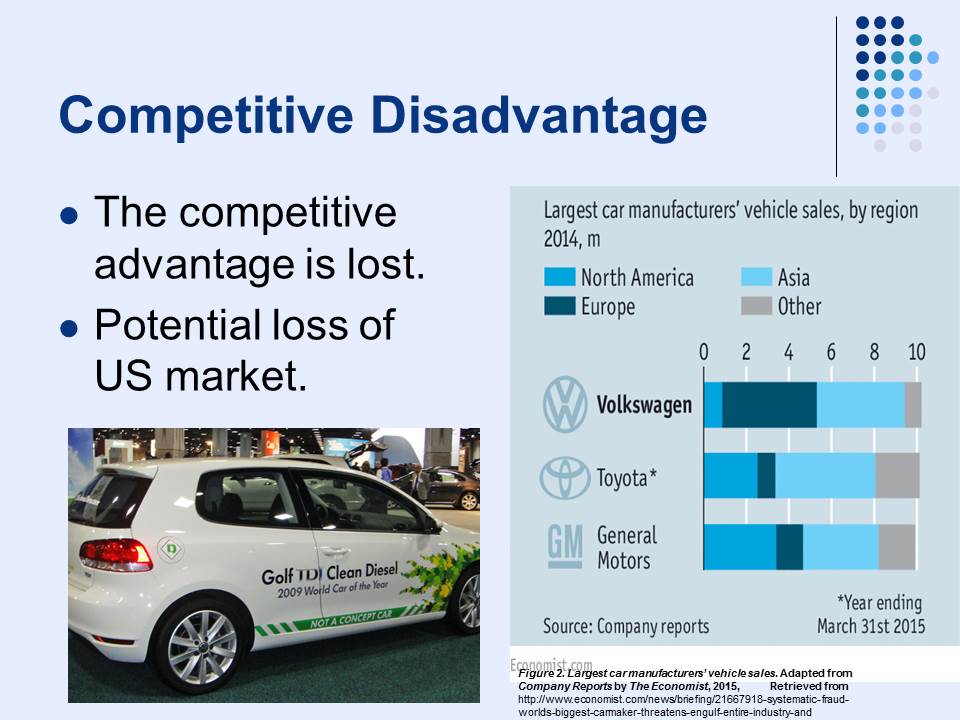
Pre-Crisis Strategy (Volkswagen AG, 2014)
- Aimed at growth (particularly in the US market).
- Focusing on R&D and customers’ satisfaction.
- Previous CEO, Martin Winterkorn.
According to the official website of VW AG (2014), the strategy of the company before the scandal was aimed at expansion and growth. The company planned to position VW AG as the “global economic and environmental leader among automobile manufacturers” (VW AG, 2014, para. 1). The goals of the company included a focus on the technologies and customers’ satisfaction; the aims of the company dealt with the volumes of sales and return on sales that were to be increased. As it was already mentioned, the company insisted on “focusing in particular on the environmentally friendly orientation and profitability of our vehicle projects” (VW AG, 2014, para. 6). The company’s management claims to be especially concerned with customers’ satisfaction and reports that the company aims at customizing its products to suit the needs of various markets.

In-Crisis Strategy (Reiter & Rauwald, 2015)
- New CEO, Matthias Mueller.
- Main concern: reputation.
- Revision of corporate culture: layoffs.
- Plans on meeting the production requirements.
It should be pointed out that a proper analysis of the current company’s strategy will need to be carried out later when this strategy becomes obvious in its true form. For the time being, however, we can analyze the current actions and suggestions of the CEO and the company and attempt to deduce how VW is managing its crisis.
The following facts about VW and its CEO’s behavior can provide us with relevant information.
In reaction to the crisis, which is being faced by the company, VW’s strategy is being reformed as the new CEO, Matthias Mueller, intends to revise the company’s policies while sticking to its top values and goals. In fact, the reorganization offered by him was created before the scandal (Reiter & Rauwald, 2015, para. 1-2). The main Mueller’s concern is the company’s reputation while the key to repairing it, in his opinion is related to VW’s corporate culture which is going to be revised. The key suggestions concerning this aspect include increasing the inclusiveness and participation, transparency, and honesty. The decision was prompted by the claim that valuable information concerning cheating has been withheld from the upper managers. In consistency with this suggestion is the decision of allowing more authority to individual brands and regions. Apart from that, a number of employees have been dismissed, but the names are not disclosed (Reiter & Rauwald, 2015). Finally, by October 7 VW was expected to present a plan for making the production meet the requirements. The analysis and evaluation of the strategy are presented in the following section.
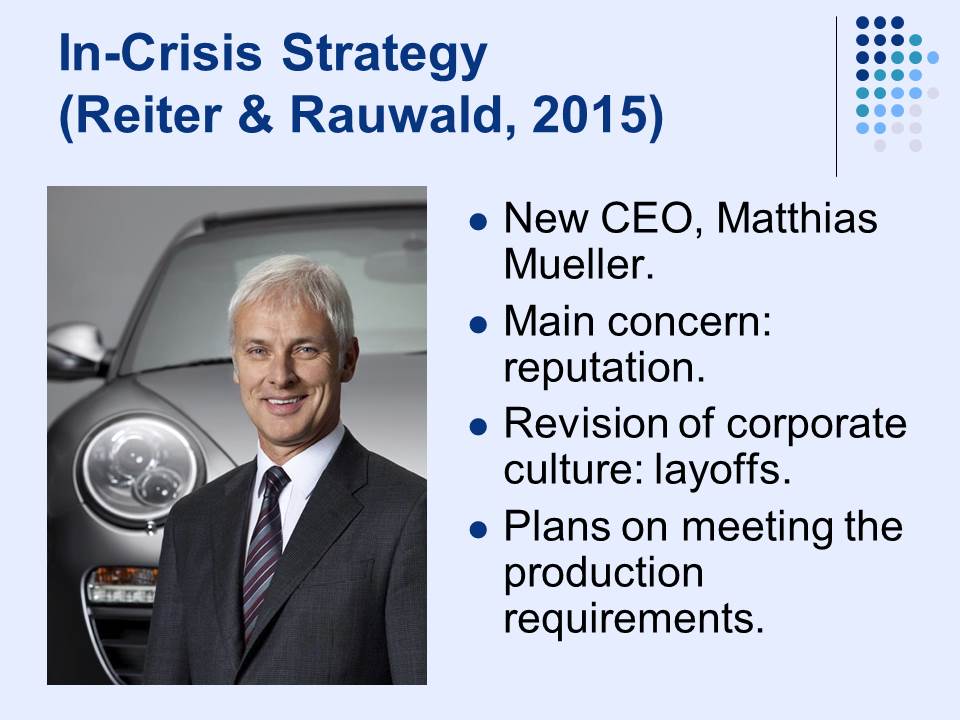
Crisis and Crisis Management in Volkswagen (Heller & Darling, 2012)
Since the situation that VW finds itself in should be described as a crisis, it is strategic crisis management that the company will have to carry out. A crisis can be defined as “a significant issue affecting a firm or its stakeholders that, if unattended, can lead to severely negative outcomes” (Penuel, Statler & Hagen, 2013, p. 196). The stages of a crisis include four steps: the pre-crisis stage, the acute crisis stage, the chronic crisis stage, and that of recovery; the guidelines for crisis management correspond to these stages (Heller & Darling, 2012). Therefore, the stages of crisis management may include the detection, preparation and (when possible) prevention, response (that typically includes damage containment and control), recovery, as well as revision (Penuel et al., 2013, p. 197; Heller and Darling, 2012; Andrews, A., Simon, J., Tian, F., & Zhao, J., 2011).
The crisis of VW appears to be three-fold. It would not be an overestimation to say that the crisis of reputation is in its acute stage; the production crisis that covers the creation of flawed cars for several years can be defined as a chronic one. Finally, there is also a corporate culture crisis that VW’s CEO is planning to resolve; its stage appears to be chronic as well. Currently, the company seems to be in the stage of response as it attempts to contain the damage and create planning for the recovery. This is the type of strategy that is going to be discussed in the paper.
- Pre-crisis opportunities are missed.
- Acute reputation crisis is the primary concern.
- Chronic R&D crisis get less attention.
We may conclude that VW has failed to prevent the crisis at the pre-crisis stage, although the information concerning the problem was available two years ago, after the International Council on Clean Transportation tests. As Mr. Mueller claims, poor information exchange has happened between the senior managers. In any case, the opportunities of pre-crisis stage appear to be lost.
It seems plausible that the company has already carried out research, and the conclusions appear to have led the CEO to suggest that the core of the problem lies in the corporate culture difficulties. As a result, he has targeted this problem officially and publically; by demonstrating his efforts he attends the reputation crisis as well. The official information concerning the current VW crisis management strategy is mostly concerned with the values crisis; the production crisis appears to be vastly underrepresented.
The endeavor of demanding transparency and honesty as the company’s ethical conduct guidelines appears to be a rational decision. Even though the question of information withdrawal is hard to check, it is obvious that such a problem must be solved and avoided in future since it is a requirement for a successful business strategy (Neilson, G.L., Martin, K.L., & Powers, E., 2008). Still, by emphasizing the withdrawals, values revision, and corporate culture changes, VW’s CEO appears to avoid describing the strategies of production crisis management.
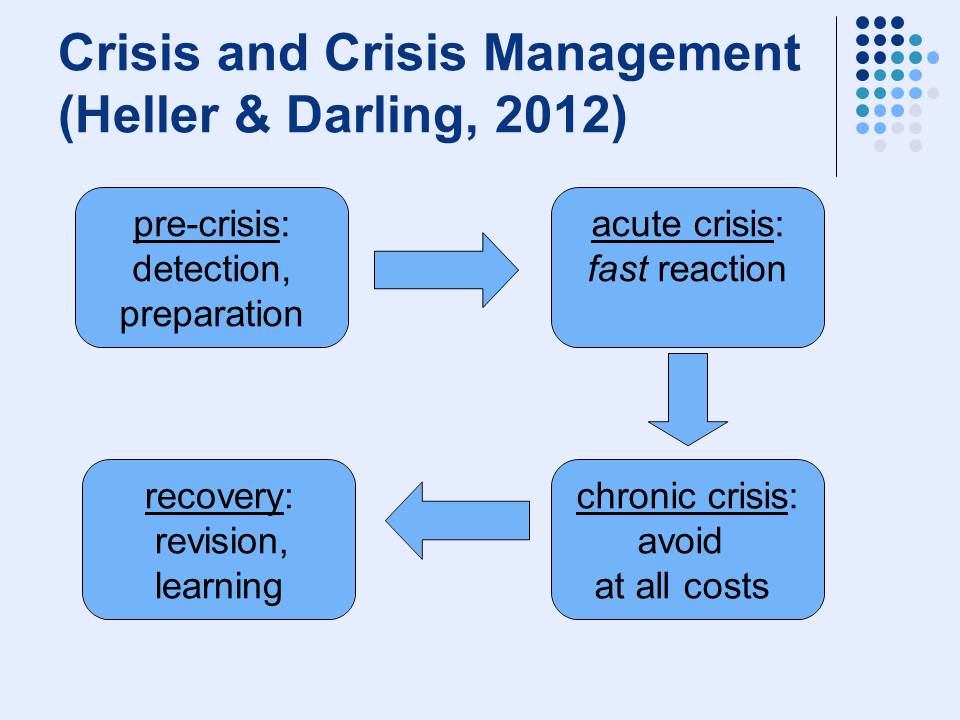
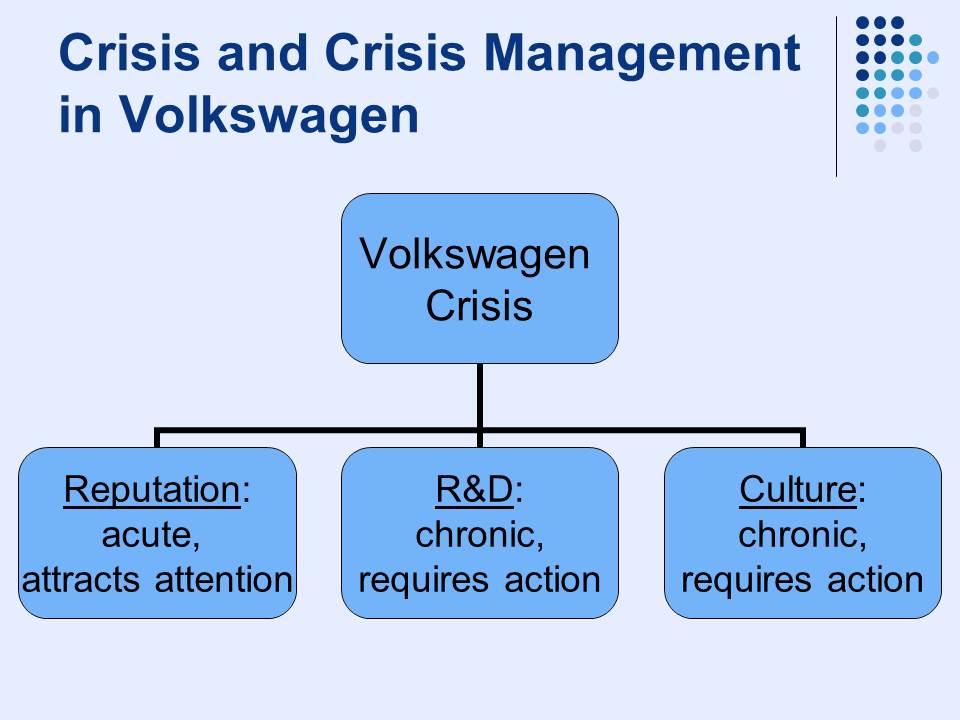
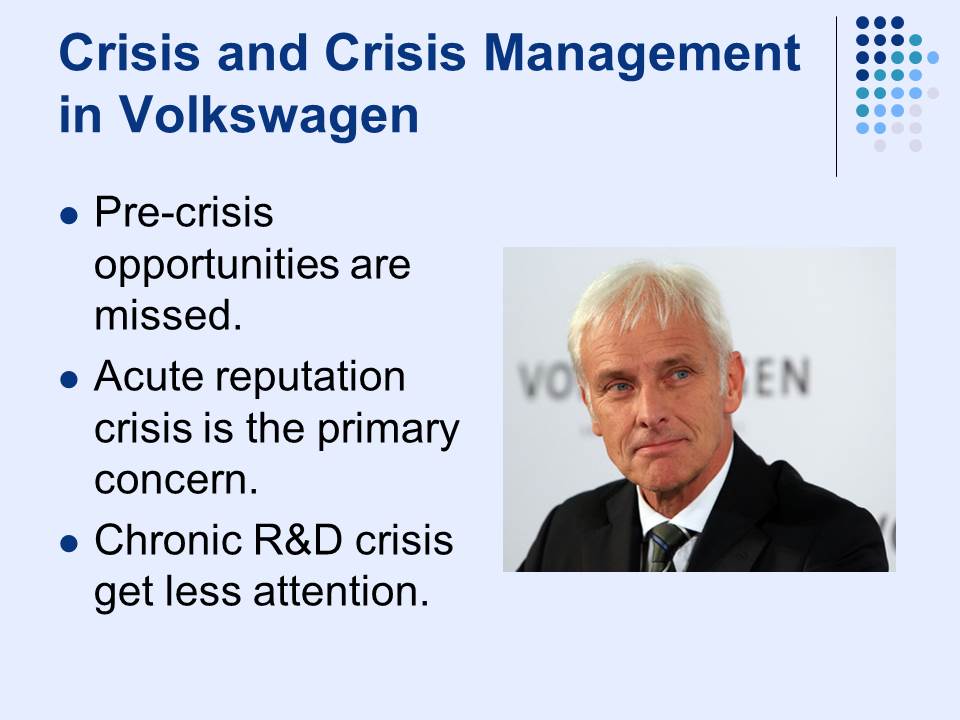
Alternatives
Current strategy:
Concentration on one of the crisis aspects (most visible/convenient).
- Advantages:
- lattending to the core of the problem;
- lresources.
- Disadvantages:
- one-dimensional;
- the threat of neglecting other aspects.
We draw our conclusions from the fact that VW appears to be concentrating on the cultural crisis which seems to have been introduced for the sake of restoring the company’s reputation. The mission and vision, human capital, and organizational culture are indeed among the key dimensions of strategic leadership (Coulter, 2013). Apart from that it is obvious that all the aspects of the crisis are interconnected and interrelated, and the production crisis appears to be caused by the cultural one. In this light, the strategy of VW seems to be rational, as the core problem is given primary consideration and attended prior to the rest of the difficulties. This strategy would include refraining from changing the current course of action, even though it is still rather vaguely defined. The strategy would involve developing a consistent plan of actions concerning culture revision. The main advantage of this alternative consists in focusing the resources and efforts on one goal; the disadvantage is in a rather one-sided view of the problem which could result in mismanagement of other crisis aspects.
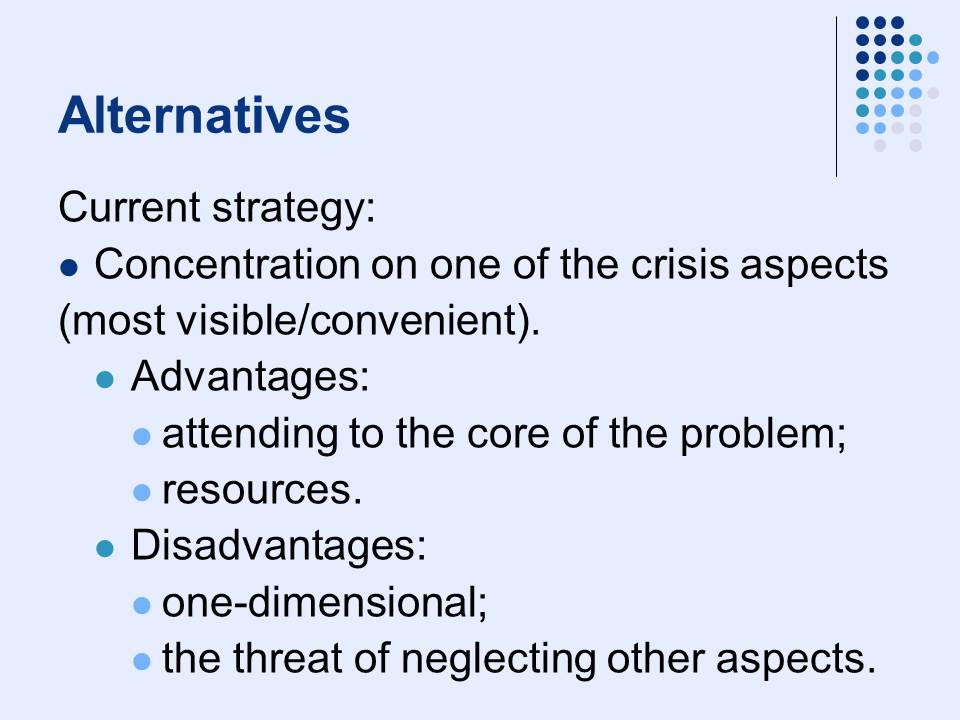
Alternatives and Recommendations
Suggested strategy:
Taking into account all the aspects.
- Disadvantages:
- dispersed effort;
- resource-consuming.
- Advantages:
- necessary resources are available;
- holistic approach.
Alternatively, the company could pay equal attention to the crises without shifting the emphasis on one of them. The possible disadvantage of this alternative lies in the fact that the crisis-management resources are going to be dispersed. However, given the fact that a giant car manufacturer like VW possesses resources in generous amounts, this problem appears to be manageable. In this case, an active production crisis management should be carried out and officially demonstrated to facilitate the process of reputation restoration. At the same time, the demonstration of corporate culture revision would be carried out but neither of the problems would be regarded as the most important one as both of them depend on each other. The official demonstration, on the other hand, is bound to contribute to the solution of the reputation crisis; therefore, all the dimensions of the crisis are going to be attended in this case. The second alternative is the one that appears to be most advisable and, at the same time, manageable for a company like VW.
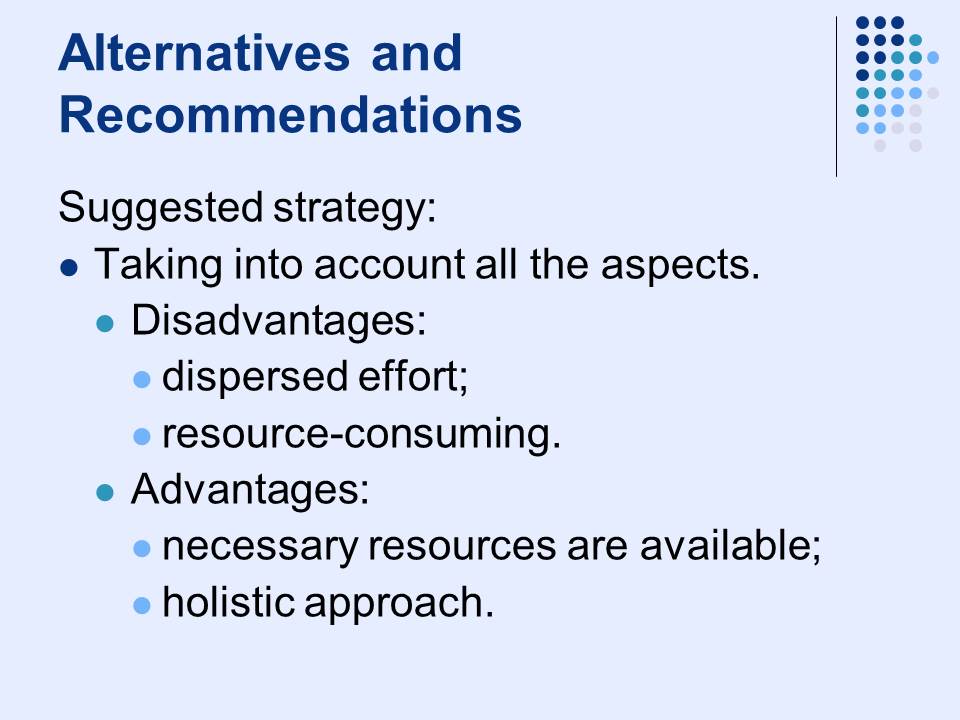
Discussion
- Similar scandals are not to be had in future.
- CEO’s actions produce the impression of searching for the “guilty party”.
One of the main advantages of the suggested alternative is the fact that while VW has managed to successfully “cheat” on EPA for years, a second scandal of this kind might be too much for the company, and, to avoid it, all the crises must be resolved. VW pointedly demonstrates active management of the crisis, which is undeniably important for public relations, but instead of focusing on the fraud itself, the CEO makes an impression of searching for the guilty party.
- R&D problems are to be solved as soon as possible.
- Reputation is difficult to restore.
Opportunity for change?
It would appear most logical for the company to provide the proofs of fixing the production crisis as soon as possible, even though this would not immediately solve the reputation crisis. Given the fact that the corporate culture revision has already been announced, this line of action should also be developed. By attending the crisis as a system, VW has the chance of resolving it faster and more efficiently.
Even though it is obvious that a crisis situation endangers business, it is also often regarded as an opportunity for change (Penuel et al., 2013, p. 187). Since the legal and ethical obligation of providing ecologically-friendly cars was not enough of a stimulus for VW to spur research and develop technologies, possibly, this crisis will allow it an opportunity of revising and improving several aspects of its operation, and, consequently, a new competitive advantage might be found by the company, one that would allow it restore its reputation and position in the world market.
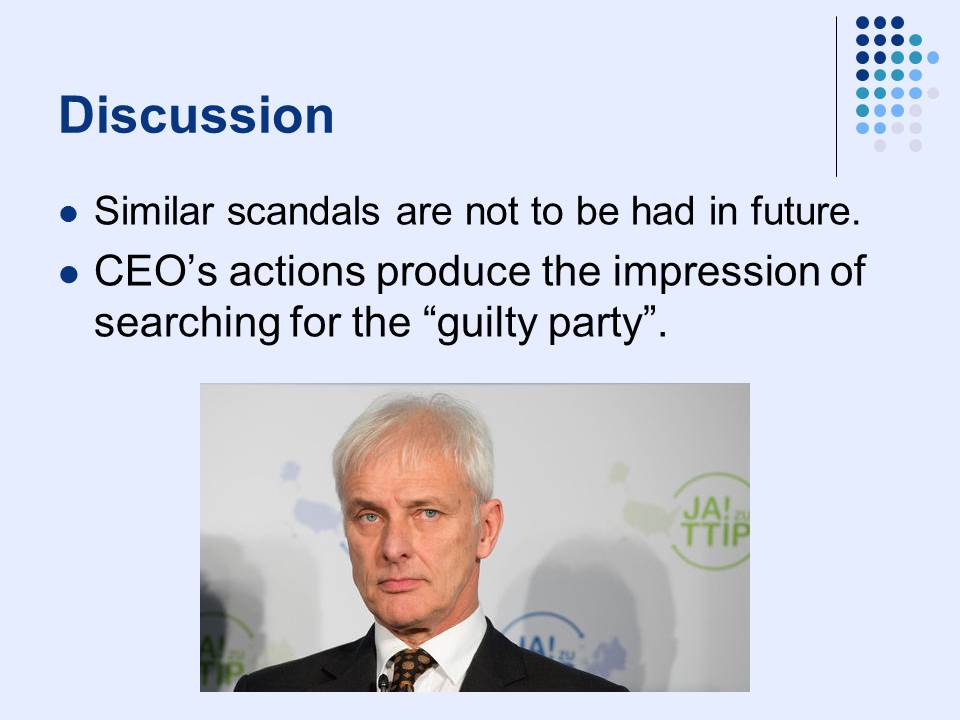
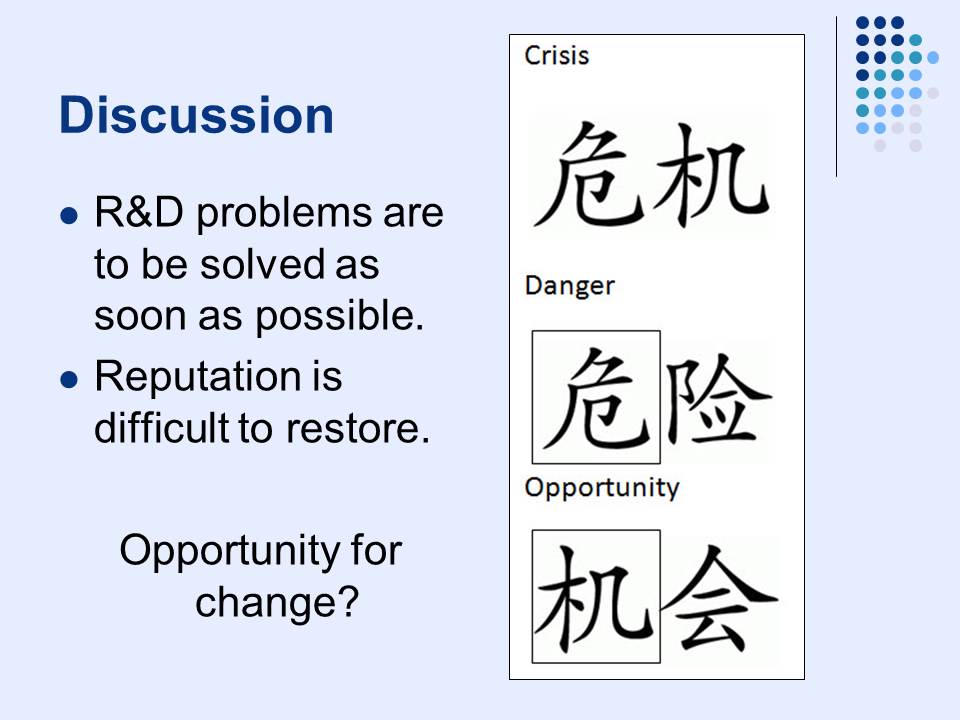
Conclusion
- Full-fledged three-dimensional crisis.
- Attending to all crisis dimensions is advisable.
- Loss of the competitive advantage.
- The current strategy is focused on the acute reputational crisis.
With all the things considered, let us sum up this presentation for you. The current situation of VW can be described as a full-fledged three-dimensional crisis. The main drawback of the current strategy is its focus on searching for the guilty party. The suggested crisis management alternative consists in attending to all the aspects of the multidimensional crisis and publically demonstrating this to improve the damaged reputation. Apart from that, it should be pointed out that the competitive advantage that VW had prided itself on has been lost along with the customers’ trust. The problem of searching for a new competitive advantage would be necessary to attend as soon as the damage caused by the crisis is contained and minimized.
- Resources are available.
- How will they be allocated?
The company appears to have analyzed the situation, but its current strategy is likely to be revised. In either case, VW has admitted having the problem both to the public and itself and appears to be willing to change the situation. It is not unlikely that the company will seize the opportunity of improving its performance and R&D. In several months, we will be able to find out if its strategic decisions and crisis management are efficient.
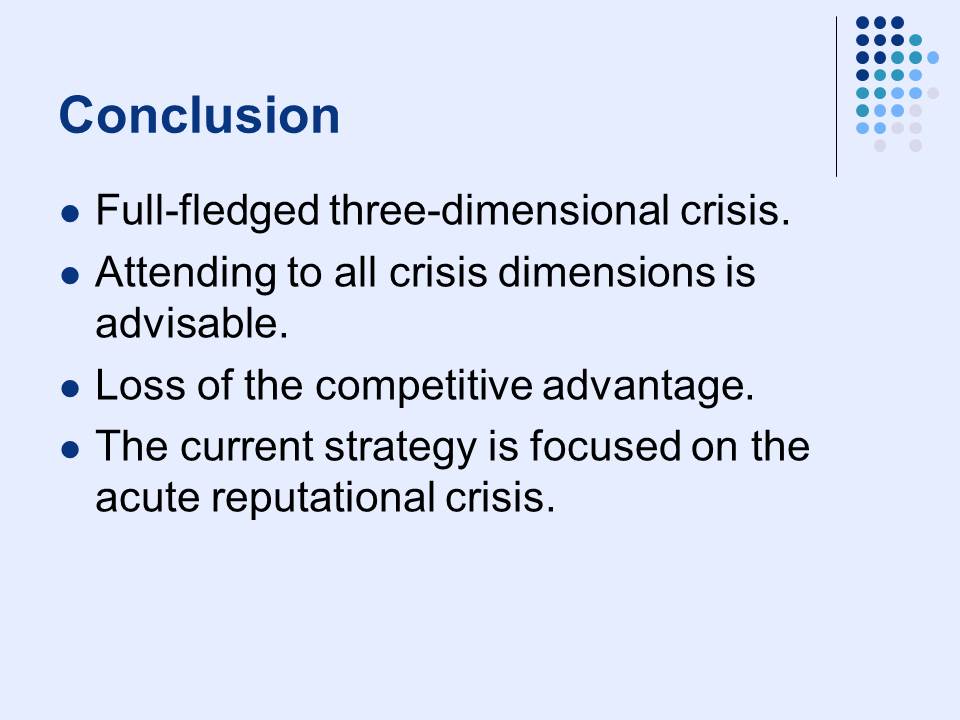
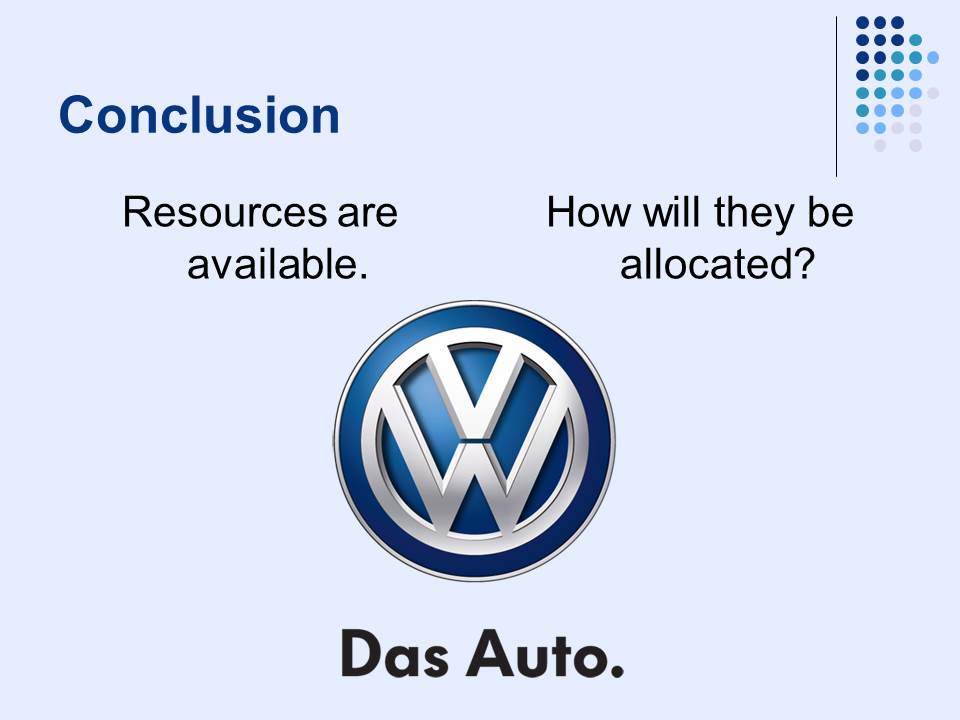
References
A mucky business. (2015). The Economist. Web.
Beene, R. (2015a). Self-certification under scrutiny. Automotive News, 89(6693), 4. Web.
Beene, R. (2015b). VW faced ultimatum from EPA. Automotive News, 89(6691), 1. Web.
Bloomberg Business. (2015). Volkswagen Ag. Web.
Crash [Image]. (2015). Web.
Heller, V., & Darling, J. (2012). Anatomy of crisis management: lessons from the infamous Toyota Case. European Business Review, 24(2), 151-168. Web.
Hoover’s. (2015). Volkswagen AG Competition. Web.
Largest car manufacturers’ vehicle sales. [Image]. (2015). Web.
Kapadia, D. (Producer, Reporter), & Downs, G. (Producer). (2015). Volkswagen Emissions Scandal in Numbers [Video]. United States: Wall Street Journal.
Reiter, C., & Rauwald, C. (2015). VW’s New CEO Is Moving Forward With a Strategy Shift. Bloomberg Business. Web.
Volkswagen AG. (2014). Group Strategy 2018. Web.